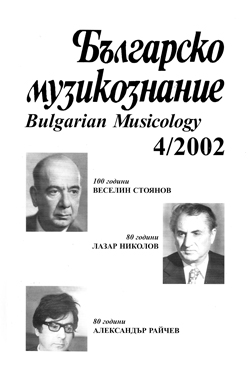За някои композиционни похвати в клавирните концерти на Веселин Стоянов
On Some Composition Techniques in Vesselin Stojanov's Piano Concertos
Author(s): Nadja KrustevaSubject(s): Music
Published by: Институт за изследване на изкуствата, Българска академия на науките
Summary/Abstract: In the three piano concertos of Vesselin Stojanov (First - A-minor, 1951; Second - D-minor, 1962; Third - B-flat major, 1969) one is impressed by the building up of a guiding line in the piano part, the evidence of a certain type of monody. This type of monody in the right hand is frequently lined with repetition i.e. the melody is located in a wider sound space, comprising several registers or it is saturated with massive three-tone and four-tone chords for both hands. The tones of the harmonious filling can be seen as forming short inner melodic lines without that being sufficiently expressed polyphony. The left hand contains harmonious accompaniment, which, however, represents a more broken up melodic line, moving along the tones of harmony and could be considered a more simplified counterpoint of the main melody. In other words - t he harmonious movement is in a more static line which counterpoints with the more ornamented melody in the right hand. At the same time the left hand touches upon some inner voices through the hidden polyphony of crucial and leaping tones. I have introduced the working term “arpeggio lines” for this type of structure. The virtuoso passages take a large space in Vesselin Stojanov’s piano concertos. A characteristic feature of the gradual passages is that they correspond with the folklore traditions to such an extent that they can be seen as an original imitation of the folklore instrumental ornamentation. Another tendency is the frequent presence toccata movements. Even metaphorically we could call Vesselin Stojanov’s concertos toccatas. In this study I examine all the three techniques, which, in my opinion, are characteristic for the piano thinking of the composer, who is justifiably considered to be one of the classics of Bulgarian piano works.
Journal: Българско музикознание
- Issue Year: 2002
- Issue No: 4
- Page Range: 107-114
- Page Count: 8
- Content File-PDF

